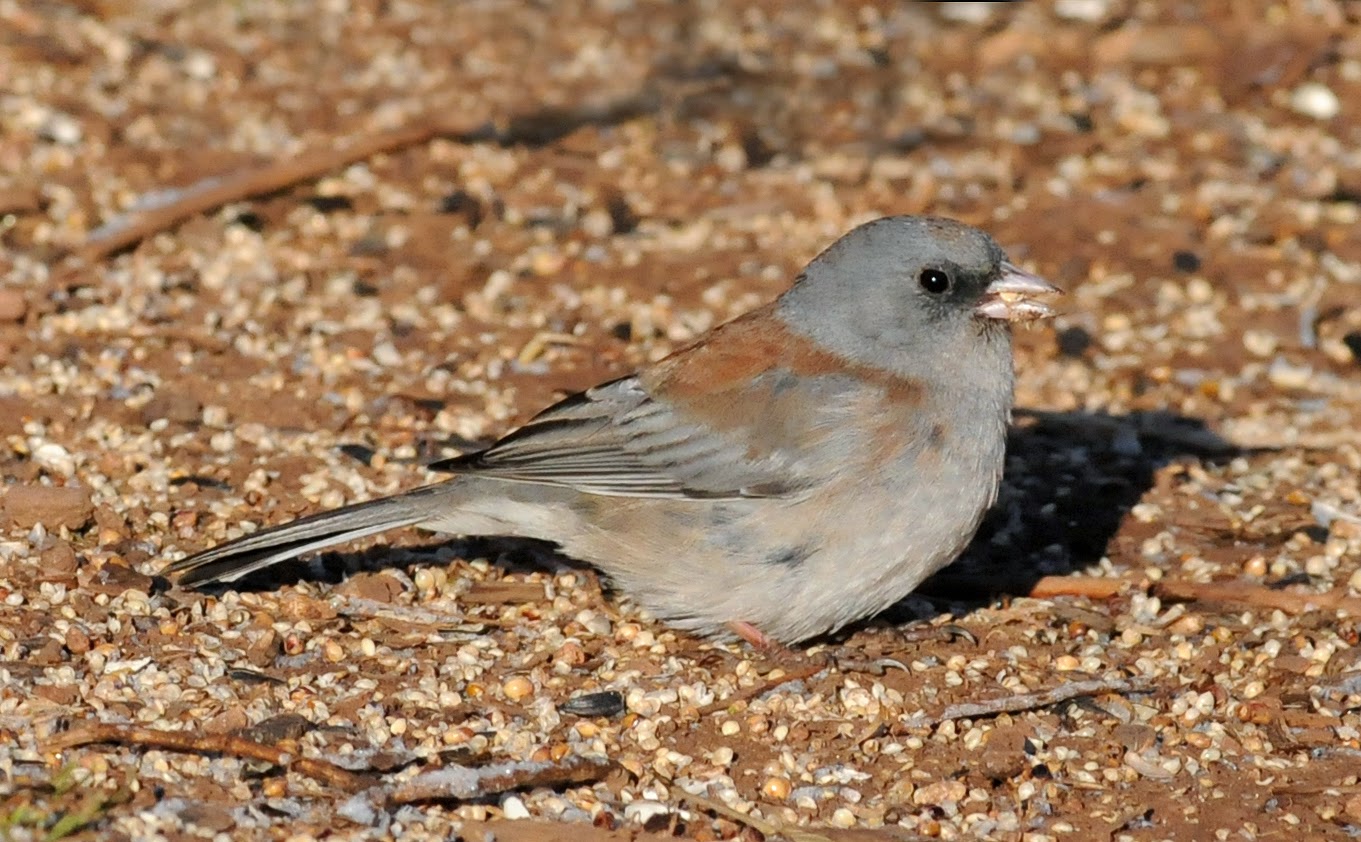Dark-eyed Junco intergrade ('Pink-sided Junco' x 'Grey-headed Junco'), Red Rocks Trading Post, Jefferson County (Colorado, USA), 7th January 2012 - copyright Steve Mlodinow
(photo ID: 1334)
(photo ID: 1334)
When is it appropriate to use the term intergrade rather than hybrid? This is a question that seems to cause some confusion at times so I thought it was worth exploring and throwing out my thoughts for others to build on.
In practice intergrade seems most often to be used in relation to crosses between different subspecies while hybrid is reserved for crosses between different species. However this doesn't seem very satisfactory as a definition, as the taxonomic status of different taxa may move between species and subspecies or vice versa - should we suddenly change whether we call something a species or a hybrid just because taxonomists have changed their mind over whether the two taxa are different species or not? And what about different taxa where one authority treats them as different species while another as subspecies of the same species? Should we call them intergrades by one authority and hybrids by another?
Having considered a number of different scenarios I reached the conclusion that I was asking the wrong question. It is not a case of either hybrid or intergrade and working out where one starts and the other ends. The words are not mutually exclusive. Maybe this was obvious to some people already, but I suspect I'm not alone in having failed to appreciated it up to now. In fact I'm sure I'm not as Eugene M McCarthy devotes a section to the issue in his Handbook of Avian Hybrids of the World (Oxford University Press 2006) (he also seems to come at it with the premise that most biologists choose the words according to whether the parent taxa are different species or not).
I realised that the term intergrade is easy to define if I stop being concerned about how it relates to the term hybrid. It's the product of intergradation! So if the ranges of two populations of different taxa overlap and there is intergradation between the two populations, we have intergrades. This implies that crosses between the two taxa are fertile and backcross with either or both parent taxa or with each other. In other words if there is extensive gene flow between the two taxa then where this genetic exchange takes place the crosses are intergrades. This works independently of the taxonomic status of the two taxa - it doesn't matter if they are different species (like Western Gull and Glaucous-winged Gull) or different subspecies of a single species (like Red-shafted Flicker and Yellow-shafter Flicker).
In this article I defined a bird hybrid as a bird that is the offspring of parents that do not both belong to the same species. Given the changing nature of taxonomic classification it doesn't seem to much of a stretch to assume the broadest concept of species, so allowing crosses between phylogenetically distinct taxa that may be treated as subspecies by some authorities to be classed as hybrids.
If I've got this right then it allows some crosses, such as Glaucous-winged Gull x Western Gull, to be accurately described as both hybrids and intergrades. Where no intergradation occurs the crosses may only be described as hybrids.
Western Gull x Glaucous-winged Gull hybrid (and intergrade),
Species mentioned:
Western Gull Larus occidentalis
Glaucous-winged Gull Larus glaucescens
Yellow-shafted Flicker Colaptes auratus luteus
Red-shafted Flicker Colaptes auratus cafer
Dark-eyed Junco Junco hyemalis 'Pink-sided Junco' Junco hyemalis mearnsi-group 'Grey-headed Junco' Junco hyemalis caniceps-group



I, too, realized I didn't know the difference between a hybrid and an intergrade and went googling. This is how I found your article and blog. I also found an eBird post about its updated taxonomy as of August 15, 2015. Here are the definitions they give:
ReplyDeleteHybrid: Hybrid between two species, e.g., American Black Duck x Mallard (hybrid)
Intergrade: Hybrid between two ISSF (subspecies or subspecies groups), e.g., Mallard (Mexican intergrade)
ISSF or Identifiable Sub-specific Group: Identifiable subspecies or group of subspecies, e.g., Mallard (Mexican)
Here is the URL for the post: http://help.ebird.org/customer/portal/articles/1006825-the-ebird-taxonomy
Thanks Charles - that seems to correspond pretty much with the idea that hybrids are between species and intergrades are between subspecies - except with the extension of the latter to include groups of subspecies rather than merely individual subspecies. And that extension makes practical sense if we are to stick with this as a definition, as we often use vernacular names for groups of subspecies rather than names for a single subspecies (e.g. Myrtle Warbler x Audobon's Warbler intergrades where Myrtle can, in theory if not in practice, be either coronata or hooveri and Audubon's can be auduboni, nigrifons or goldmani). I still feel that that definition is lacking, as it depends on the current and sometimes almost arbitrary taxonomic treatment rather than the reality of what is actually going on with the birds.
ReplyDelete